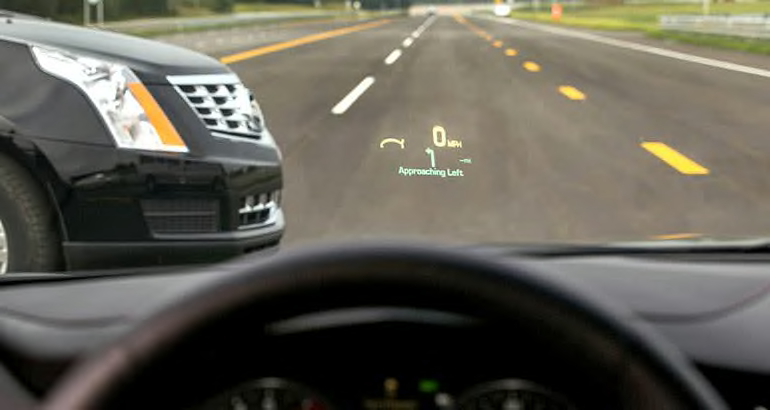
The auto industry announced Thursday that it plans to install 5 million pieces of vehicle-to-everything (V2X) equipment over the next five years, but only if the Federal Communications Commission reverses course on a plan to take away airwaves currently reserved for development of the technology.
The announcement came from the Alliance for Automotive Innovation, the industry's main trade group in Washington. The group represents 28 automakers as well as technology suppliers, such as Bosch and Intel.
John Bozzella, president and CEO of the Alliance, described the plan as "a major turning point" in the effort to realize the safety potential of V2X, a technology that enables cars to communicate over the airwaves with each other and smart infrastructure, such as traffic signals, to prevent collisions and to smooth traffic flow.
The number of V2X transmitters in cars on the road would increase by 50 times, Bozzella said in an interview. "Our commitment sends a clear message. We're on the cusp of widespread V2X deployment."
But the industry commitment hinges on a big "if," because the FCC is currently weighing a plan to take more than half of the airwaves currently reserved for V2X technology and use it for WiFi instead.
"We're creating a virtuous cycle," Bozzella says. "We want to create the right environment for both vehicle and infrastructure deployments to flourish, because they inform each other. The more vehicles with V2X radios deployed, the more likely we are to see public investment in roadside unit infrastructure."
In 1999, the FCC agreed to set aside a portion of airwaves for the development of future communications among vehicles and infrastructure, such as roads, traffic signals, or lampposts. The reserved airwaves have been called the "Safety Spectrum" by the Department of Transportation, AAA, the National Safety Council, and other groups.
The DOT and safety experts have projected that V2X could improve safety dramatically, potentially saving thousands of lives a year.
Development over the years has been slow going, however, with various approaches to V2X competing for deeper investment and wider adoption. Until now, only a few automakers—including General Motors, Ford, and Audi—have pledged to deploy V2X technology. Toyota backed off a V2X commitment last year due to uncertainty about the FCC plan.
Even with 5 million transmitters on the roads in the future, the number of V2X-capable vehicles will be a tiny fraction of the hundreds of millions of cars and trucks currently operating in the U.S.
But the industry pledge could act as a catalyst that accelerates deployments by individual automakers and local governments, which have invested in transmitters for infrastructure, says William Wallace, manager of safety policy at Consumer Reports.
"This shows a level of agreement across the auto industry we haven't seen before on this issue," Wallace says. "It's truly something new."
Transportation Airwaves
In December, the FCC announced a plan to split the spectrum set aside for V2X. Of the 75 MHz currently available, 45 MHz would be repurposed for WiFi. The FCC said the remaining 30 MHz should be adequate for V2X communications. Many parts of the tech industry welcomed the FCC's plan as a way to unleash the economic potential of WiFi and high-speed 5G connectivity.
Some experts doubt that 30 MHz is enough room for V2X to work well, especially because there are two competing V2X technologies: C-V2X, a cellular-based system, and Dedicated Short-Range Communications, a radio-based system.
As part of its lobbying effort with the FCC, the Alliance on April 28 outlined a plan for resolving the technical problem of how the two competing technologies could share the 75 megahertz of airwaves as industry and government work out which technology should prevail and become the mainstream choice for wide deployment in cars and infrastructure.
In a letter to Transportation Secretary Elaine Chao, the trade group suggested dividing the reserved airwaves between the two technologies, with automakers and local governments and regulators researching how well they worked for a period of five years. A process would be established for choosing which one should prevail. The other technology would continue to operate on part of the spectrum for 10 years, so any investments already made wouldn't go to waste.
Consumer Reports filed formal comments in March to the FCC about the regulatory proposal, raising serious concerns about the impact on V2X safety applications. CR also called for federal agencies to ensure that all new cars and trucks have V2X capability within five years. CR's comments were part of the FCC's process, asking for input from the public, interested stakeholders, and the industry before making a proposed regulation final.
"The FCC should not move forward with its proposal unless it can prove that doing so will not jeopardize safety on our roads, now or in the future," Wallace says.
But other countries have concluded that 30 MHz is enough bandwidth for V2X technology to work well, said Michael Calebrese, director of the wireless future program at the Open Technology Institute. The auto industry's conditions for bringing out V2X equipment present a false choice because the FCC figured out a way to deliver V2X using less of the spectrum, he said.
If the FCC sticks to its plan, consumers would benefit because they "need and deserve both next-generation WiFi connectivity and improved auto safety," Calebrese said.
Thursday's announcement is striking because the auto industry, safety groups, and the Department of Transportation all agree now that the Safety Spectrum should be preserved, says Kelly Funkhouser, head of connected and automated vehicle testing at Consumer Reports.
"This is a terrific development," Funkhouser says. "With such a broad coalition against the FCC proposal, it is clear that preserving the Safety Spectrum is the right thing to do."
Last month, Ford sounded an alarm after some testing showed that WiFi in the bands near the safety spectrum could cause interference that would reduce the effectiveness of V2X.
Another potential safety problem is interference between the two V2X technologies the auto industry wants to use, Funkhouser says. The FCC must produce the data to show that both can work effectively on different channels in the transportation band, she says.
"The bottom line is we want this stuff out there as soon as possible," Funkhouser says. "But we have to make sure the technology works and that it's rolled out safely."

Editor's note: This version was changed to reflect that on April 28, the Alliance released a plan for how the airwaves reserved for auto safety could be split between two competing V2X technologies. The story was originally published on April 23.
















